The story of the Continent of Mu is one of the most captivating legends of lost civilizations that have been passed down through the ages. Also known as Lemuria, this mysterious land is believed to have been a thriving civilization that existed in the Pacific Ocean thousands of years ago. However, its existence has been shrouded in mystery, and many scholars debate whether it was a real place or just a myth. This article aims to explore the fascinating history of the Continent of Mu, its myths and theories, and its potential significance for our understanding of human history.
Myths and Legends of the Continent of Mu:
The history of the Continent of Mu is deeply rooted in myth and legend, and its origins can be traced back to ancient civilizations such as the Maya and the Egyptians. According to legend, the Continent of Mu was a vast land that stretched from the Pacific to the Indian Ocean, and was home to a highly advanced civilization that flourished for thousands of years. The inhabitants of Mu were said to possess incredible knowledge and technology, including the ability to harness the power of the elements and communicate telepathically. However, their peaceful existence was threatened by a series of cataclysmic events, including earthquakes and volcanic eruptions, which eventually caused the land to sink beneath the waves.
Theories and Controversies:
While the myth of the Continent of Mu has captured the imagination of many people, it has also been the subject of much debate and controversy among scholars. Some researchers argue that Mu was a real place and that the legend is based on historical events, while others dismiss it as a complete myth with no basis in reality. There are also various theories about the origins of the inhabitants of Mu and their supposed advanced knowledge and technology. Some speculate that they were a race of extraterrestrial beings or that they were the survivors of a lost civilization from Atlantis. Others believe that Mu was simply a part of a larger landmass that was destroyed by natural disasters.
Evidence for the Existence of Mu:
Despite the lack of concrete evidence for the existence of Mu, there are some intriguing clues that suggest that the legend may have some basis in reality. One of the most compelling pieces of evidence is the existence of underwater structures and ruins in various parts of the Pacific, which some researchers believe could be remnants of the lost continent. These structures include megalithic stones, temples, and pyramids, which bear similarities to ancient structures found in other parts of the world. There are also claims that certain artifacts, such as the Pacific Stone Maps, provide evidence of the existence of an advanced civilization that existed in the Pacific before it was submerged.
The Significance of the Continent of Mu:
The legend of the Continent of Mu has inspired countless books, movies, and works of art, and its significance extends far beyond its mythological roots. For some, it represents a lost civilization that holds the key to unlocking the secrets of human history and technology. Others see it as a metaphor for the fragile state of our planet and the dangers of ignoring the signs of environmental destruction. The legend of Mu also highlights the universal human desire to explore the unknown and to seek answers to life’s biggest questions.
The Search for Mu:
Over the years, many explorers and researchers have attempted to find evidence of Mu’s existence. Some have focused on the Pacific region, where they have searched for underwater structures or geological formations that could be remnants of the lost continent. Others have looked to ancient texts and artifacts from around the world in an attempt to piece together the story of Mu and its people.
However, despite decades of research and exploration, no conclusive evidence of Mu’s existence has ever been found. Some scholars believe that the legend of Mu may have been based on real historical events, such as the rise and fall of ancient civilizations in the Pacific region. Others argue that the story of Mu is purely a myth, created by imaginative writers and fueled by the human desire for adventure and discovery.
Conclusion:
The story of the Continent of Mu is a fascinating and mysterious tale that continues to capture the imagination of people around the world. While its existence remains a matter of debate among scholars, the legend of Mu serves as a reminder of the many mysteries and wonders that still await discovery. Whether it was a real place or just a myth, the legacy of Mu has left an indelible mark on human history and culture, and its enduring appeal is a testament to the enduring power of myth and legend. So, next time you gaze out at the vast expanse of the Pacific Ocean, take a moment to imagine what wonders may lie beneath the waves, and who knows, you may just catch a glimpse of the lost continent of Mu.
FAQs:
Q: Was the Continent of Mu a real place? A: The existence of Mu is still a matter of debate among scholars, and there is no conclusive evidence to prove or disprove its existence.
Q: What caused the land of Mu to sink? A: According to legend, the sinking of Mu was caused by a series of cataclysmic events, including earthquakes and volcanic eruptions.
Q: Are there any underwater structures that could be remnants of Mu? A: There are various underwater ruins and structures in the Pacific that some researchers believe could be remnants of Mu, but their origins are still a matter of debate.
Q: What is the significance of the legend of Mu? A: The legend of Mu has captured the imagination of many people and has inspired numerous works of art and literature. It also highlights the mysterious and unknown aspects of human history and reminds us that there may be undiscovered civilizations and lands that are waiting to be uncovered.





Comment here